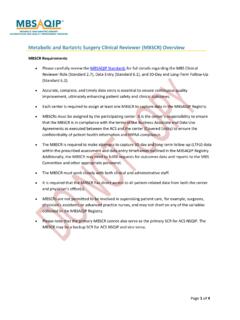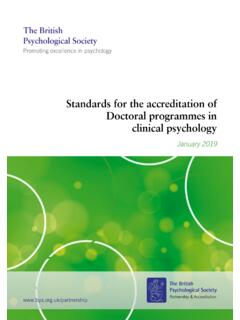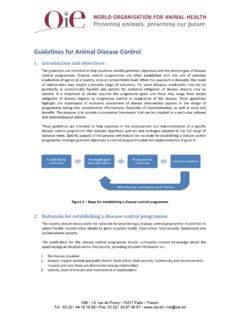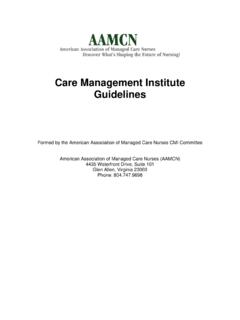Transcription of National Accreditation Program For Breast Centers
1 National Accreditation Program For Breast Centers Standards Manual2018 EDITIONACCREDITATION makes a difference2 Table of ContentsACCREDITATION MAKES A DIFFERENCET able of ContentsDisclaimer 4 Acknowledgements 5 The NAPBC 6 7 The Accreditation Process 8 11 Accreditation Information 12 Chapter 1: Center Leadership 13 22 Standard : Level of Responsibility and Accountability 14 17 Standard : Multidisciplinary Breast Care Conference 18 20 Standard : Evaluation and Management Guidelines 21 Chapter 2.
2 Clinical Services 23 60 Standard : Multidisciplinary Patient Management 24 Standard : Patient Navigation 25 26 Standard : Breast Conservation 27 28 Standard : Sentinel Node Biopsy 29 30 Standard : Breast Cancer Surveillance 31 Standard : Breast Cancer Staging 32 33 Standard : Pathology 34 35 Standard : Breast Imaging 36 37 Standard : Needle Biopsy 38 Standard.
3 Ultrasonography 39 40 Standard : Stereotactic Core Needle Biopsy 41 Standard : Radiation Oncology 42 44 Standard : Medical Oncology 45 46 Standard : Nursing 47 Standard : Support and Rehabilitation 48 49 Standard : Genetic Evaluation and Management 50 52 Standard : Educational Resources 53 Standard : Reconstructive Surgery 54 55 Table of ContentsTable of ContentsStandard : Evaluation and Management of Non-Malignant Breast Disease 56 57 Standard : Breast Cancer Survivorship Care 58 60 Chapter 3: Research 61 64 Standard.
4 Clinical Trial Information 62 Standard : Clinical Trial Accrual 63 64 Chapter 4: Community Outreach 65 68 Standard : Education, Prevention, and Early Detection Programs 66 67 Chapter 5: Professional Education 69 7 2 Standard : Breast Care Team Continuing Education 70 72 Chapter 6: Quality Improvement 73 76 Standard.
5 Quality and Outcomes 74 76 Glossary 77 794 Accreditation MAKES A DIFFERENCED isclaimerDisclaimerThe National Accreditation Program for Breast Centers Standards Manual is intended as an instructive tool to assist health care providers and institutions in improving the care of patients with Breast disease. It is not intended to replace the professional judgment of the physician, health care provider, or health care administrator in individual circumstances. The American College of Surgeons and the National Accreditation Program for Breast Centers cannot accept, and expressly disclaim, liability for claims arising from the use of this STANDARDS MANUAL 2018 EDITIONSTANDARDS AND Accreditation COMMITTEE Terry Sarantou, MD, FACS, Chair Barbara Rabinowitz, PhD, Vice-Chair Paul Baron, MD, FACS Cynthia Boudreaux, LPN, CTR Anees Chagpar, MD, FACS, FRCS(C) James Connolly, MD, FCAP Jill Dietz, MD, FACS Jessica Everett, MS, CGC Erica Fischer-Cartlidge, MSN, CNS, CBCN, AOCNS Teresa Heckel, MBA Scott H.
6 Kurtzman, MD, FACS Alison Laidley, MD, FACS Claudia Lee, MBA Ruth O Regan, MD Robert Rosenberg, MD Dana Smetherman, MD, MPH, FACR Scott Weissman, MS AcknowledgmentsACKNOWLEDGMENT OF CONTRIBUTORSThe National Accreditation Program for Breast Centers (NAPBC) is thankful to its Board for their efforts to improve the care and treatment of Breast cancer patients both in the United States and internationally. Specifically, the NAPBC acknowledges the many contributions of the members of the Standards and Accreditation Committee who were vital to the creation of the 2018 National Accreditation Program for Breast Centers Standards CONTRIBUTORS Steffanye Hawbaker Mack Ashley Logan Karen Pollitt Karen Taubert-Boone David Winchester, MD, FACSThe NAPBC6 Accreditation MAKES A DIFFERENCENAPBC BACKGROUND AND THE VALUE OF ACCREDITATIONThe evaluation and management of patients with diseases of the Breast historically occurred in a fragmented, disorganized setting.
7 In this complex environment patients are best managed through multidisciplinary coordination. This team approach resulted in the birth of the Breast center concept in the United States in the 1970s. In the past three to four decades there has been a proliferation of Breast Centers to accommodate the thousands of women diagnosed with Breast cancer, as well as addressing the equally compelling needs of the many women presenting with non-malignant Breast diseases. Evidence-based and consensus-developed standards have gained increasing importance and recognition. The United States health care system is undergoing a dramatic transformation centered on quality measurement and improvement and documentation of adherence to broadly accepted standards of care for all diseases including those of the Breast . No other organization has established standards for the evaluation and management of patients with diseases of the Breast or a survey process to monitor compliance.
8 In order to improve the quality of evaluation and management of patients, the NAPBC accredits established Breast Centers . It recognizes that, in the United States, Breast care is delivered in heterogeneous settings. The Accreditation Program is designed to be inclusive. Accreditation is awarded to academic medical Centers , teaching hospitals, hospitals, freestanding Centers , and private practices provided the NAPBC standards are met. NAPBC-accredited Centers demonstrate the following services: A multidisciplinary team approach to coordinate the best care and treatment options available Access to Breast -specific information, education, and support Breast center data collection on quality indicators for subspecialties involved in Breast cancer diagnosis and treatment Ongoing monitoring and improvement of care Information about participation in clinical trials and new treatment optionsThe National Accreditation Program for Breast Centers (NAPBC)NAPBC MISSION STATEMENTThe National Accreditation Program for Breast Centers (NAPBC)
9 Is a consortium of National , professional organizations focused on Breast health and dedicated to the improvement of quality outcomes of patients with diseases of the Breast through evidence-based standards and patient and professional NAPBCThe NAPBC7 NAPBC STANDARDS MANUAL 2018 EDITIONNAPBC BOARD MEMBER ORGANIZATIONS American Cancer Society American College of Radiology Commission on Breast Imaging American College of Radiology Imaging Network American College of Surgeons American Institute of Radiologic Pathology American Society of Breast Surgeons American Society of Clinical Oncology American Society of Plastic Surgeons American Society for Radiation Oncology Association of Cancer Executives Association of Oncology Social Work College of American Pathologists National Cancer Registrars Association National Consortium of Breast Centers
10 National Society of Genetic Counselors Oncology Nursing Society Society of Breast Imaging Society of Surgical Oncology BENEFITS OF BECOMING AN NAPBC-ACCREDITED CENTER Accreditation by the NAPBC provides many notable benefits that will enhance a Breast center and its quality of patient care. NAPBC-accredited Breast Centers receive the following: A model for organizing and managing a Breast center to ensure multidisciplinary, integrated, and comprehensive Breast care services Internal and external assessment of Breast center performance based on recognized standards to demonstrate a commitment to quality care Recognition as having met performance measures for high-quality Breast care established by National health care organizations National recognition and public promotion Participation in a National Breast Disease Database to report patterns of care and effect quality improvement (in development) Access to Breast center comparison benchmark reports containing National aggregate data and individual center data to assess patterns of care and outcomes relative to National norms (in development)











